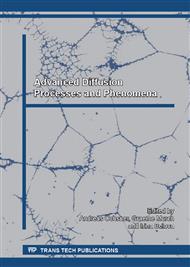[1]
P. Buffat J. P. Borel, Size effect on the melting temperature of gold particles, Physical Review A. 13 (1976) 2287.
DOI: 10.1103/physreva.13.2287
Google Scholar
[2]
C. Yan D. Xue, Formation of Nb2O5 Nanotube Arrays Through Phase Transformation, Advanced Materials. 20 (2008) 1055-1058.
DOI: 10.1002/adma.200701752
Google Scholar
[3]
J. Liu D. Xue, Thermal oxidation strategy towards porous metal oxide hollow architectures, Advanced Materials. 20 (2008) 2622-2627.
DOI: 10.1002/adma.200800208
Google Scholar
[4]
C. Yan D. Xue, Solution growth of nano-to microscopic ZnO on Zn, Journal of Crystal Growth. 310 (2008) 1836-1840.
DOI: 10.1016/j.jcrysgro.2007.10.060
Google Scholar
[5]
B. Wen, J. E. Sader, J. J. Boland, Mechanical properties of ZnO nanowires, Physical review letters. 101 (2008) 175502.
Google Scholar
[6]
C. Klingshirn, The Luminescence of ZnO under High One‐and Two‐Quantum Excitation, physica status solidi (b). 71 (1975) 547-556.
DOI: 10.1002/pssb.2220710216
Google Scholar
[7]
M. Kakazey, V. Melnikova, T. Sreckovic, T. Tomila, M. Ristic, Evolution of the microstructure of disperse Zinc-oxide during tribophysical activation, Journal of materials science. 34 (1999) 1691-1697.
DOI: 10.1023/a:1004553305665
Google Scholar
[8]
E. Comini, G. Faglia, G. Sberveglieri, Z. Pan, Z. L. Wang, Stable and highly sensitive gas sensors based on semiconducting oxide nanobelts, Applied Physics Letters. 81 (2002) 1869-1871.
DOI: 10.1063/1.1504867
Google Scholar
[9]
X. Bai, P. Gao, Z. L. Wang, E. Wang, Dual-mode mechanical resonance of individual ZnO nanobelts, Applied Physics Letters. 82 (2003) 4806-4808.
DOI: 10.1063/1.1587878
Google Scholar
[10]
Z. Tang, G. K. Wong, P. Yu, M. Kawasaki, A. Ohtomo, H. Koinuma, Y. Segawa, Room-temperature ultraviolet laser emission from self-assembled ZnO microcrystallite thin films, Applied Physics Letters. 72 (1998) 3270.
DOI: 10.1063/1.121620
Google Scholar
[11]
S. Yamabi H. Imai, Growth conditions for wurtzite zinc oxide films in aqueous solutions, Journal of materials chemistry. 12 (2002) 3773-3778.
DOI: 10.1039/b205384e
Google Scholar
[12]
D. Li H. Haneda, Morphologies of zinc oxide particles and their effects on photocatalysis, Chemosphere. 51 (2003) 129-137.
DOI: 10.1016/s0045-6535(02)00787-7
Google Scholar
[13]
M. Krunks E. Mellikov, Zinc oxide thin films by the spray pyrolysis method, Thin Solid Films. 270 (1995) 33-36.
DOI: 10.1016/0040-6090(95)06893-7
Google Scholar
[14]
R. A. Brown, J. E. Evans, N. A. Smith, A. Tarat, D. R. Jones, C. J. Barnett, T. G. Maffeis, The effect of metal layers on the morphology and optical properties of hydrothermally grown zinc oxide nanowires, Journal of Materials Science. (2013) 1-6.
DOI: 10.1007/s10853-013-7271-3
Google Scholar
[15]
F. Soofivand, M. Salavati-Niasari, F. Mohandes, Novel Precursor-assisted Synthesis and Characterization of Zinc Oxide Nanoparticles/nanofibers, Materials Letters. (2013).
DOI: 10.1016/j.matlet.2013.01.129
Google Scholar
[16]
F. Médard, A. Trichet, Z. Chen, L. Dang, M. Richard, "Toward Room Temperature One-Dimensional Quantum Fluid in the Solid State: Exciton Polaritons in Zinc Oxide Microwires," in Physics of Quantum Fluids, ed: Springer, 2013, pp.231-255.
DOI: 10.1007/978-3-642-37569-9_11
Google Scholar
[17]
M. Winkelmann, E.-M. Grimm, T. Comunian, B. Freudig, Y. Zhou, W. Gerlinger, B. Sachweh, H. Petra Schuchmann, Controlled droplet coalescence in miniemulsions to synthesize zinc oxide nanoparticles by precipitation, Chemical Engineering Science. 92 (2013) 126-133.
DOI: 10.1016/j.ces.2012.12.049
Google Scholar
[18]
M. Darroudi, Z. Sabouri, R. Kazemi Oskuee, A. Khorsand Zak, H. Kargar, M. H. N. A. Hamid, Sol–gel synthesis, characterization, and neurotoxicity effect of zinc oxide nanoparticles using gum tragacanth, Ceramics International. (2013).
DOI: 10.1016/j.ceramint.2013.05.021
Google Scholar
[19]
N. R. A. Latiff, H. Zaid, N. Yahya, B. Demiral, "Novel enhanced oil recovery method using dielectric zinc oxide nanoparticles activated by electromagnetic waves," in National Postgraduate Conference (NPC), 2011, 2011, pp.1-7.
DOI: 10.1109/natpc.2011.6136450
Google Scholar
[20]
M. Alaskar, M. Ames, S. Connor, C. Liu, Y. Cui, K. Li, R. Horne, Nanoparticle and Microparticle Flow in Porous and Fractured Media--An Experimental Study, SPE Journal. 17 (2012) 1160-1171.
DOI: 10.2118/146752-pa
Google Scholar
[21]
F. Reincke, S. G. Hickey, W. K. Kegel, D. Vanmaekelbergh, Spontaneous assembly of a monolayer of charged gold nanocrystals at the water/oil interface, Angewandte Chemie International Edition. 43 (2004) 458-462.
DOI: 10.1002/anie.200352339
Google Scholar
[22]
B. P. Binks, Particles as surfactants—similarities and differences, Current Opinion in Colloid & Interface Science. 7 (2002) 21-41.
DOI: 10.1016/s1359-0294(02)00008-0
Google Scholar
[23]
F. Bresme J. Faraudo, Orientational transitions of anisotropic nanoparticles at liquid–liquid interfaces, Journal of Physics: Condensed Matter. 19 (2007) 375110.
DOI: 10.1088/0953-8984/19/37/375110
Google Scholar


